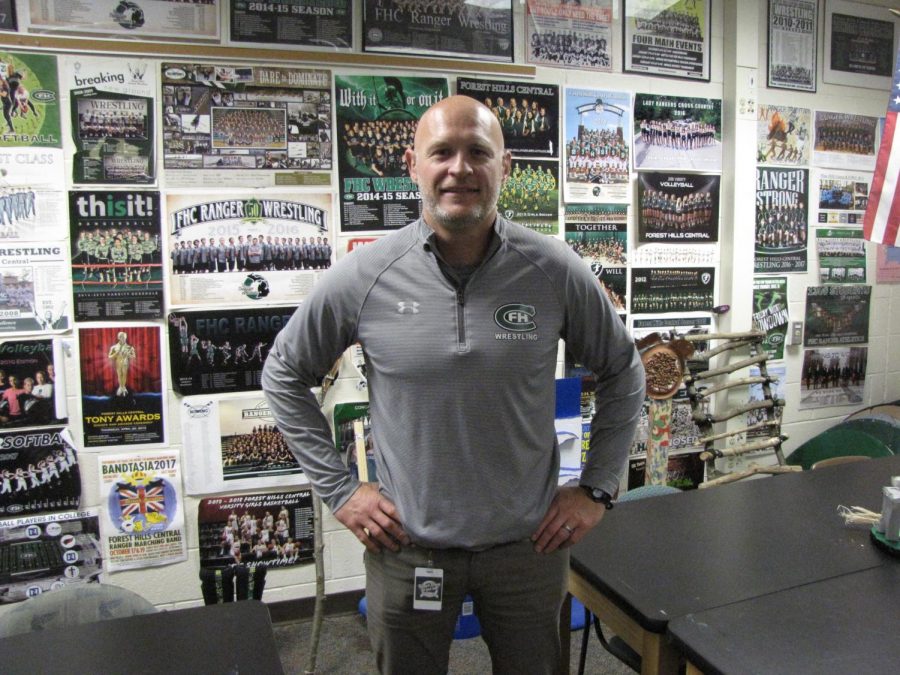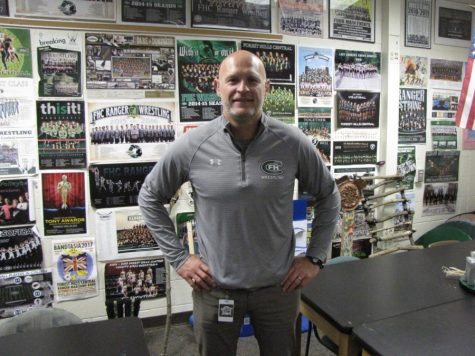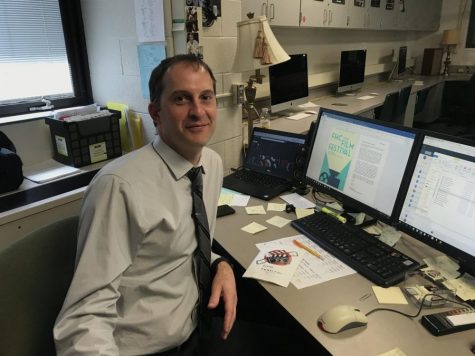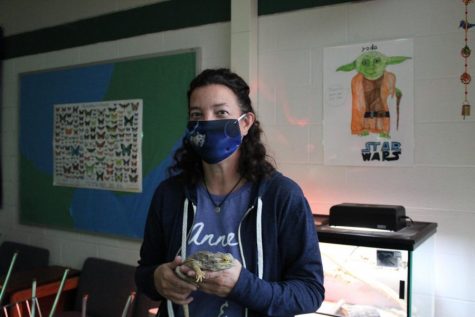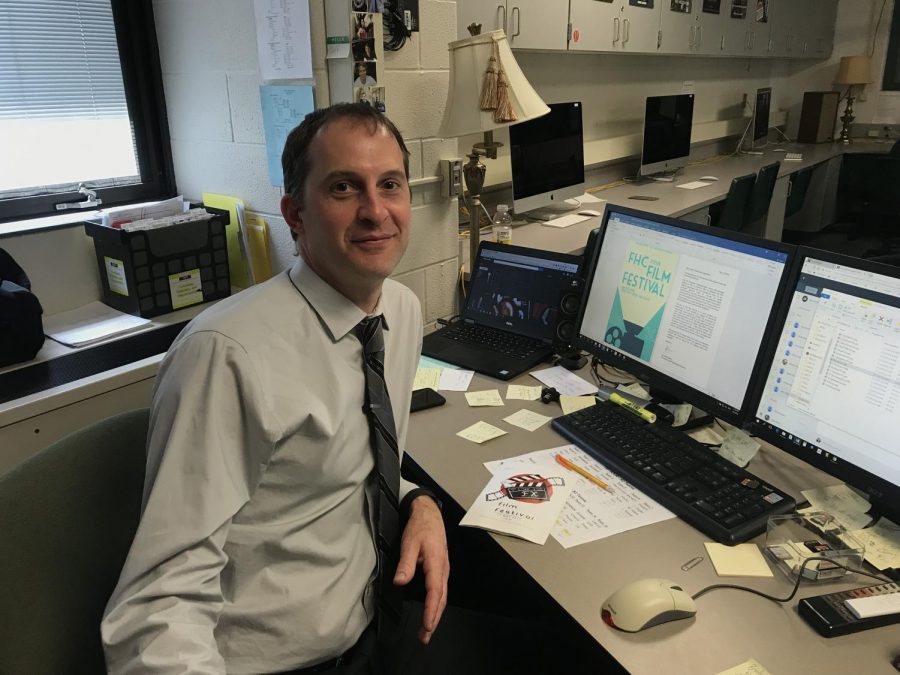History teacher, Brad Anderson, standing in front a wall in his classroom, circa 2019
Inauguration Day in the classroom: a Q&A with Mr. Anderson
Name: Mr. Brad Anderson
Classes: AP World History
How many of your classes did you show the inauguration today, and for how long?
“I started it when the dignitaries started to enter the US Capital and went out onto what is commonly referred to as kind of the ‘Front Porch of Democracy,’ onto the balcony of the Capitol; so when the former presidents started coming onto the stage—about 11:30 [a.m.]—I tuned in and watched it through its entirety.”
Why do you feel like the inauguration was important for your students to see during class today?
“Well, it’s been a hard year, and all throughout history—as we study in my class, 10,000 years of human history—the peaceful transfer of power is not routine, nor normal in many cases. For 240 years, our country has watched the peaceful transfer of power through war, through pandemic, through civil strife, and we watched it again today. And it’s a national turning of a new chapter. Nothing’s magically going to be changed tomorrow. Nothing’s magically going to be different for the bad or for the good tomorrow. But as we mark our time in this country, it’s marked by presidential administrations and far ranging events like COVID-19. So that’s why I watched it today, because inaugural addresses are studied in APUSH and regular US History and in Civics class. The views that we see are etched into the memory of our national collective conscious. And so I want my students to have an avenue to see that. They might not ever watch it; they might not have tuned in today if they were hybrid, and that’s their right to do so, but [I think] they’ll be thankful in the long run, when they’re my age and beyond, that they did.”
How do you think watching the inauguration directly ties into your students’ education?
“Education is more than content. Education is more than what goes on the whiteboard or on a slideshow or in a Zoom lesson. I look at education more as enrichment. We’re at where we’re at, largely, in our country because we have a terrible national memory. We have not learned from the lessons of the past. We have the collective memory of a butterfly, and history has been ignored too often. So, you know, as far as their education goes, this to me is the ultimate enrichment. We need to see things like this; today, the message to all Americans was unity, coming together, putting aside the political differences—whether you’re red or blue or you don’t care—when you see political rivals—heated, political rivals—come together, stand together, it means that tomorrow, maybe for a little while, we can work together. And if they can do it, we can do it. And if they can put aside huge national challenges for a day to say, ‘Hey, let’s come together,’ I hope that we can see that lesson and do the same in our neighborhoods, in our schools, and [in] our communities. So I like students to see history live.”
Did you have any experiences similar to this one in your education experience? If so, were you grateful for that?
“Now I’m going on 40 years old; I’ll be 40 this year. And so I was telling the students that I remember the first inauguration I watched, and I don’t remember a word that was said, but I watched George H. W. Bush in 1989 get inaugurated. And you know, that didn’t leave a huge impact on me, but it’s the collective view of history, from tuning in during the first Gulf War—I remember seeing that on TV, the Berlin Wall coming down, the fall of the Soviet Union, all the way up to 9-11; it’s those moments in history that either tear you apart or bring you together. This one hopefully brings us together, despite whomever you supported, whomever you voted for, whomever you didn’t vote for, I hope that Inauguration Day is for all Americans.”
Inauguration Day in the classroom: a Q&A with Mr. Manders
Name: Mr. Jeff Manders
Classes: Civics, Government, Media Communications
How many of your classes did you show the inauguration in, and what parts of the inauguration did you show?
“It was really kind of around lunchtime when all the inauguration stuff was happening.”
And why did you decide to show the inauguration?
“Well, I’m the Civics and Government teacher, so it’s something we’ll definitely be talking about in Government class tomorrow. It’s also a huge historic event that happens every four years, so I think it’s important for students to understand what’s happening. Just sitting with the kids in my fourth hour there, it generated questions about ‘Well, how does this work?’ and ‘Why is that happening?’ or ‘[Who] was that person reading the oath to Kamala Harris or to President Biden?’ People don’t even know who our Supreme Court members are. My concern is some students don’t even really know what the Supreme Court is. It’s a moment in time, it’s a moment in history, that helps us bring up some of these important things. At least [to] me, as a Government teacher, it’s really important.”
Why do you think it’s important for students to tune into moments like this one?
“I mean, our democratic system is something that they’re already a part of whether they can vote or not. And then as soon as they leave here, when they become seniors and leave FHC, they are directly a part of the system. If you have a job, you’re part of the process. I think it’s something they should understand because that’s how our government was set up: to serve the needs of the people. And that democracy doesn’t work if the people aren’t paying attention to what’s happening.”
In your education experience, did you ever have a chance to witness moments like this or other historic moments?
“Do I remember any inaugurations when I was a student? I don’t think so. I kind of remember when the Berlin Wall fell, and I was in Government class at that time, so we talked about that. I barely remember the Challenger disaster. Those kinds of things I remember.”
Do you wish you had an opportunity to witness anymore of those moments?
“Yeah, I think when it plays perfectly into maybe what’s happening at school. I think we definitely need to expose students to what’s happening, especially when it involves our government. I think for almost any sort of class—it may be a stretch for others—but almost any sort of class, there’s definitely a connection.”
